When I was a teenager I remember my mother, herself a research scientist at the time, advising me that it was not how much science you knew that was important. Rather it was how to recognize whom to believe that was vital to becoming a scientifically literate citizen. Though that was some 60 years ago, it is even more important today. We are bombarded with so much science and technology information on a daily basis it’s hard to know what is real and what is fake.
Much of scientific theory is sound, evidence-based and solidly researched with universal acceptance among the scientific community and has stood the test of time. The theories of gravity, atomic structure and photosynthesis, for example, have few if any detractors. Others, though with solid research and wide scientific acceptance behind them, have groups which have their reasons not to embrace them. Darwin’s theory of evolution, the link between global warming and human actions, the causal relation between smoking and lung cancer are concepts which have skeptics among many outside the scientific community (and even among certain scientists). More troubling however is the proliferation of fake or pseudo-science among unsuspecting members of society, as McGill’s Dr Joe Schwarcz has often pointed out. The “scientific” basis of homeopathy is one such widespread fraud. The fake and discredited link between vaccination and autism is another.
So how do we decide whom to believe? How do we get our students to learn to discriminate between accepted evidence-based science and fake science – hearsay, promotions from special interest groups and unsubstantiated fear mongering? Perhaps the solution to the problem begins in the science classroom. In order for students to accept science they need to DO real science. They need to participate in meaningful scientific inquiries – ask real questions, decide what to do to find the solution and carry it out, gather and analyze appropriate evidence and come to some conclusion about their original questions. Sometimes the process is clear and expected, but frequently it can be somewhat messy and inconclusive – often giving rise to doubts and further questions. That’s the way science is.
The solar furnace
In my visits researching science activities of some of our teachers, I had the pleasure of observing Christine Pouget, a teacher at Pierrefonds Comprehensive High School. As part of her Secondary 4 science curriculum, she challenged her students to answer the question, “Can solar energy be used to heat water for cooking?” The activity, based on the curriculum areas of energy conservation and heat transfer, was a meaningful real-world topic for students – especially useful in less advantaged world contexts. Students set about designing an experiment and creating a set-up to test their hypothesis. Other than giving them a rough sketch of a possible apparatus, Christine gave the design control over to the students – working in groups of 2 or 3.
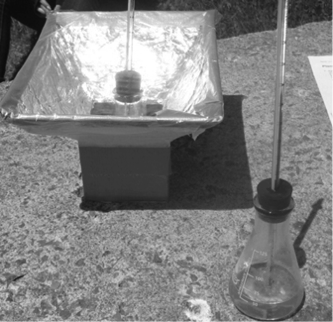
Student-made solar furnace
After some classroom discussion of heat reflection, radiation and absorption, they got to work. As shown in the photo, one group of students constructed their cooker and put in a beaker of water inside. They set it out in the sun with a control next to it and measured how much the temperature rose in each case. Comparing the temperature of the water in both the experimental and control situations, they were able to make a conclusion based on the data they collected. Though it was a simple experiment, they soon realized that there were many factors which had to be considered before coming to a clear conclusion. For how long should they collect data? Were the air temperature and wind factors? Did the time of day make a difference? What if clouds obscured the sun? In other words what appeared to lead to a clear-cut answer was much more complicated than originally anticipated.
A key benefit for the students was an emerging understanding of the scientific process. An important result of going through the scientific process for students was that they learned how to base decisions about scientific “facts” on real observed evidence. More importantly, they began to learn how to evaluate whether or not the evidence was solid enough to draw a reasonable conclusion – a vital process for evaluating “truth” and “fact”.

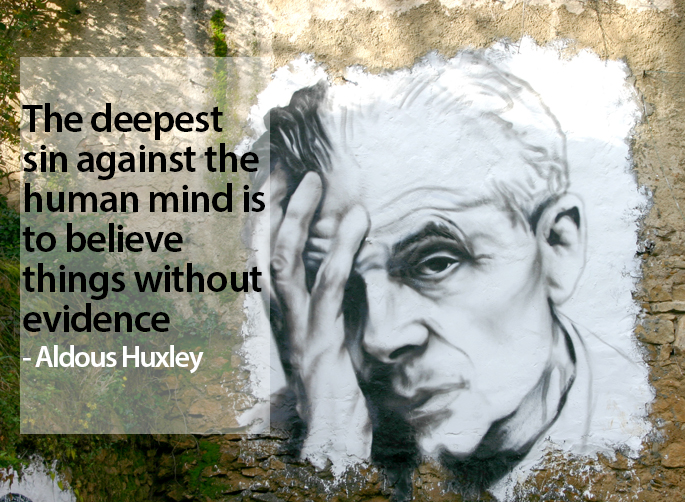
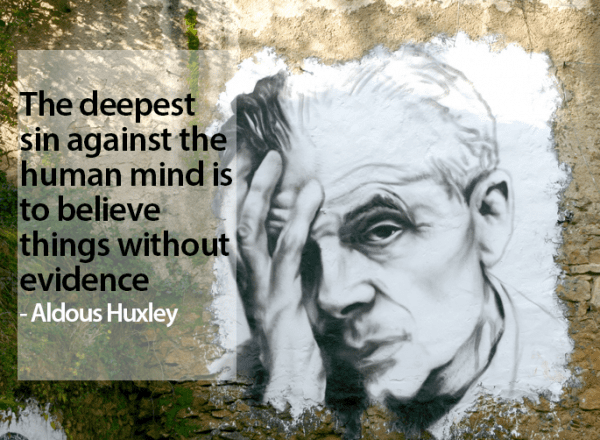
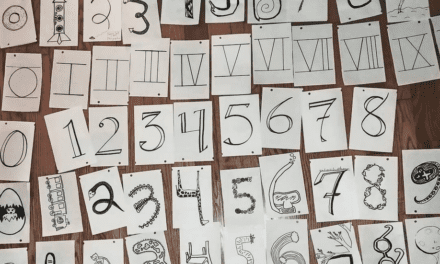

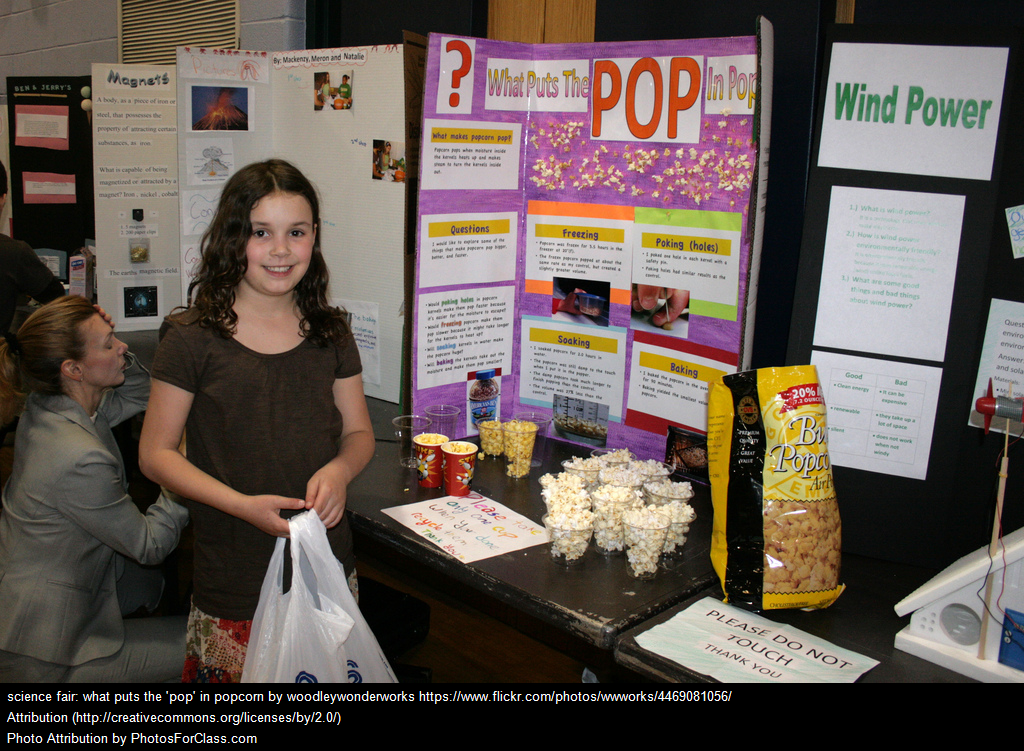
Great blog. I would suggest that this example illustrates how students can actively demonstrate if a hypothesis is valid or not. Unfortunately, the general public has been bombarded by contradictory scientific conclusions, climate change being one of them. While the overwhelming evidence supports that climate change is the result of human activity, some “scientists” have challenged this conclusion. The question is,”who are these scientists, and how can they claim they have evidence which denies climate change, or that it is the result of carbon emissions?
This is where the real concept of critical thinking comes into play. We need to show students that they need to be able to reason through arguments and not to accept in a doctrinaire fashion everything that comes before them. (Even their teachers!) Look at the sources. Are the conclusions supported by additional independent research? Are the people putting forth specious arguments actually hiding an agenda which is self-serving? During the Republican candidate campaign, one was actually quoted as saying that he did not care what the facts were, he was taking a particular stance because his stance reflected what he believed. Clearly, his message was that facts of any category were secondary to feelings and beliefs. Therein lies the rub.
I agree, Michael. An important part of science teaching is encouraging students to critically analyze the data they gather to be able to back up their (and their teachers’) conclusions.
Great blog! Important points and particularly timely. Anyone interested could read “Is Gwyneth Paltrow Wrong about Everything” by Timothy Caulfield which makes a similar point, particular trying to urge people to trust scientific, and not celebrity culture, when considering things like homeopathy and vaccines.
Without question we have a serious problem with dubious claims such as homeopathy and other snake oil. But the internet’s proliferation of misleading information on health topics is why these problems get bigger despite all the science-outreach efforts.
Another problem that often slips under the radar is that they are organisations like the American Council for Science and Health that on the surface seem to be dispelling health myths like homeopathy but are really a front-group for industries that peddle scientism for the sake of profit.
Thanks Sally. Celebrity endorsement certainly doesn’t guarantee any scientific credibility. They need to follow a program in rigorous inquiry based scientific training before creating their “theories” – as students in today’s high school science classrooms are.
A very good observation on student learning ;& a good first comment. This is a first step to students applying the same critical thinking & analysis to all the scientific information they are bombarded with. As they say, “if it’s too good to be true it probably isn’t”; as in Global Warming is a myth, for example. Keep up this concept for our students to always take the critical approach as future scientists & citizens. What a worthwhile Blog. Good luck & all the best. Keep experimenting !
Thanks Martin. That critical approach to evaluating scientific issues is so vital to a scientifically literate citizenry.
Ken, did the students eventually stumble upon the parabolic mirror which focuses all parallel incoming rays at the focus?
Speaking of conic sections, during the past few days I’ve been working through an old 1985 NASA booklet entitled “space Mathematics”, a curriculum project headed by James D. Gates. The discovery approach is also extremely important in mathematics as it is in science, and this book, although advanced for the Quebec high school curriculum, serves as an ideal model for interested teachers. The authors derive all sorts of formulas that are needed, for example, to calculate velocity-changes involved in transferring a spacecraft from one orbit to another It beautifully illustrates why the inverse square-law is consistent with an elliptical and not a circular orbit. In fact the latter would violate the conservation of energy.
Thanks for your comment Enrico. The NASA Space Mathematics booklet sounds fascinating. I recently saw the Hollywood movie “Hidden Figures” which tells the story of the women mathematicians who had such a pivotal role in the success of the early NASA space expeditions. Though it doesn’t go into the details of the mathematics, it does highlight the central role that mathematics plays.
Wow—I loved that movie! If that doesn’t inspire more students to go into math or engineering, I don’t what will!
Hi Ken:
Your comments that relate to a scientifically literate public is timely in light of the happenings south of us. It reminds me of Carl Sagan’s last interview with Charles Rose. Carl speaks of the need for intellectual skepticism and inquiry and the importance of the science curriculum in schools. It is a short gem that I would encourage everyone to view (in case you have not already had the opportunity). It speaks volumes. Google Carl Sagan’s last interview Charlie Rose.
G
Thanks for your comment Garth. The interview with Carl Sagan you refer to is certainly inspiring and thought-provoking. A couple of things stand out for me with respect to teaching science in our schools. He challenges us all to “ask skeptical questions” and to “withhold belief until there is compelling evidence” and to reject ideas if “the evidence does not support it” – good advice not only for the science classroom, but also for our citizenry in these days of increased anti-scientific populism.
Another terrific blog post here, Ken. While not all of Christine Pouget’s students will go on to careers in scientific fields, all have been imbued with a sense of the scientific method, wherein a hypothesis must be rigorously tested, and the truth realized. It is a reassuring to know that student-centred active inquiry such as this is taking place throughout Quebec’s schools.